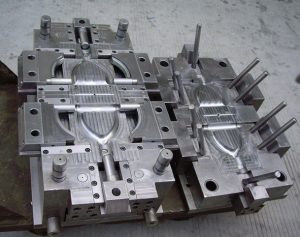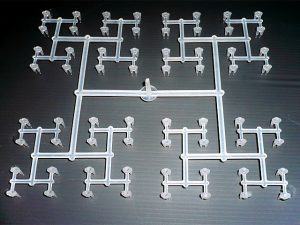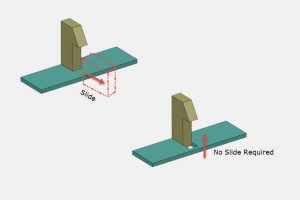- BY Rex Plastics
- POSTED IN Uncategorized
- WITH 2 COMMENTS
- PERMALINK
- STANDARD POST TYPE
The question is put to us almost daily: “I’ve got a part 4″ by 5″ by 2″, how much will the injection mold cost?” Unfortunately, there is a long list of factors that complicate that question. From expected product life to the type of plastic used, any one factor could greatly impact that final number. It’s possible to get several quotes for nearly identical injection molds, each with a slight variation, and all of them will have very different costs. In this entry, we will outline three key considerations when asking about mold cost in the US.
Size of Parts

Here, the mold base alone would have had a four-figure price tag, possibly five.
It’s easy to underestimate the cost impact of a part’s bulk, especially when its geometry is otherwise very simple. All the same, making a mold for a garbage can lid versus one for a water bottle cap presents a massive cost difference. Accounting for hundreds more labor hours and thousands more dollars of material, that could be a $40000 gap. That’s assuming both molds only have one cavity.
In other words, bigger parts require bigger injection molds, which in turn require more time to machine.
Number of Cavities

This is a 64-cavity runner tree. Notice the actual parts are quite small.
This is one of the only factors capable of making a small, easy part into a costly tooling challenge. A part cavity is an exact negative of your part’s shape in the mold that fills with plastic during injection. If your tool has more cavities, we can shoot more parts per cycle, which lowers your unit costs and order lead times.
There is a trade-off though, in that doubling the number of part cavities also doubles much of the labor and material costs to make a mold. A single cavity mold quoted at $3000 easily turns into a $60000-80000 mold for the same part if we go up to 32 cavities, depending on which bells and whistles are required for a high-cavity mold that aren’t otherwise needed.
Your target price-per-unit and/or annual volumes will usually dictate how many cavities your mold needs.
Undercuts: Complicating Injection Molds Since Forever

(Left) Area under the snap hook requires a slide action to release. (Right) Opening a hole directly below allows access for the standard mold actions, thus removing the need for a slide.
In short, undercuts are specific areas of a plastic part that need their own moving block in the mold. These blocks are necessary to form, release, and eject the part from its mold.
The simplest injection molds have no undercut hardware. They open and close like shoe boxes; there’s two halves that separate in a straight line and allow easy removal of the contents. On the other hand, molds with undercut hardware work more like Chinese puzzle boxes; each of the extra moving pieces have to open in a specific order before your parts can be ejected. Adding undercut hardware and fine-tuning that opening sequence is one of the trickiest aspects of any mold build.
If possible, it’s always best to revise a design to remove undercuts. This is because each one adds a minimum of $2000 to a mold’s cost. More often, that number is $3000-4000 each, and for large and/or complex undercuts it is even higher.
Those are just three of the factors that will have the largest impact on the cost of your mold. Other design features such as surface finish/texture and very small details can also add a lot to the cost of injection molds. We will talk more about those in Part 3 of this series. If you’re interested in learning more in the meantime, please review our price guide.
About Rex Plastics
US molding company Rex Plastics provides high-quality, low- to mid-volume production. Skilled technicians employ modern equipment and expertise in a wide range of specialty materials. With comprehensive mold building, a lifetime guarantee, production, finishing, assembly and packaging services, Rex Plastics delivers a complete product to its customers. Expert guidance and personal attention at every step of the process ensure high customer satisfaction. For more information or if you’d like a free quote please contact us at www.rexplastics.com.




hi,
this is very nice information for us,
regards,
mansi desai
The second part of the blog series on injection mold costs by Rex Plastics provides an insightful analysis of the various factors influencing pricing. The author thoroughly explores aspects such as material selection, complexity, and production volume, giving readers a well-rounded understanding of the cost dynamics. This information is invaluable for professionals considering injection molding for their projects. I want to express my gratitude to the author for this detailed post and hope they continue to share more expertise in future articles.